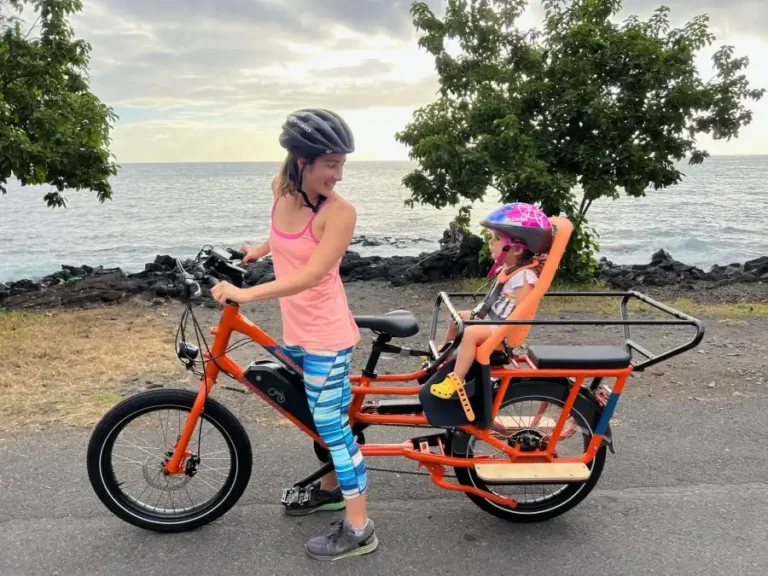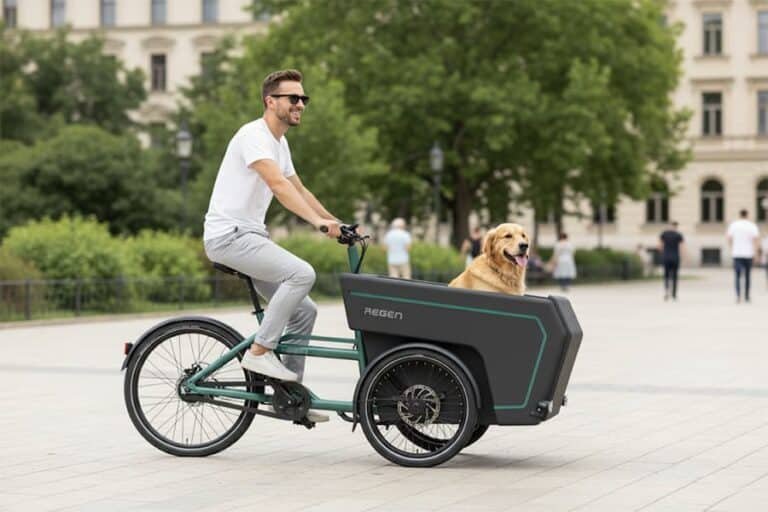Az elektromos teherbringán lévő felfüggesztési villa javítja a kényelmet, az irányítást és a tartósságot, különösen nehéz terhek szállítása vagy durva terepen való navigálás esetén. Bár nem minden kerékpáros számára elengedhetetlen, értékes funkció azok számára, akiknek fontos a simább, stabilabb utazás.
A legtöbb teherbiciklit azonban nélkül felfüggesztés. Széles, nagy térfogatú gumiabroncsokat és merev villákat használnak a stabilitás, az egyszerűség és a teherbírás maximalizálása érdekében. Ez ideális a kiszámítható városi járdákhoz - különösen, ha alacsony karbantartást és sziklaszilárd, súly alatti kormányzást szeretne.
Szóval, a teherbringáknak van felfüggesztésük? Néha. Elülső felfüggesztést láthatunk bizonyos longtaileken és egy maroknyi prémium kategóriás front-loaderen; néhány modell még hátsó felfüggesztéssel is rendelkezik. Hogy érdemes-e ezt választania, az útvonal minőségétől, a rakomány/utasok kényelmi igényeitől, valamint a többletsúlyt, a költségeket és a karbantartást illetően mutatott tűrőképességétől függ. Ez az útmutató elmagyarázza, hogyan működnek a rugós villák, mikor segítenek, mikor nem, és hogyan válassza ki a megfelelő beállítást.
Ebben a teljes útmutatóban lebontjuk:
- A felfüggesztés szerepe a kerékpárokban, és hogyan alkalmazható a teherbringákra.
- Hogyan működnek a rugós villák és milyen típusok állnak rendelkezésre.
- A teherbringa felfüggesztésének előnyei és hátrányai.
- Gyakorlati megfontolások vállalkozások és családok számára, akik a rugós vagy merev villák között döntenek.
A végére tudni fogja, hogy a rugós villa a megfelelő választás-e a teherbringa beállításaihoz - és hogyan befolyásolja a rugózás minőségét, a költségeket és a karbantartást.
A teherszállító kerékpárok általában felfüggesztéssel rendelkeznek?
A legtöbb ma kapható teherbringa alapfelszereltségként nem rendelkeznek felfüggesztett villával. A gyártók gyakran a teherbírást, a tartósságot és az alacsony karbantartást helyezik előtérbe a rugózási kényelemmel szemben. Ehelyett a teherbringák jellemzően a :
- Széles, ballonos gumiabroncsok (pl. 20" vagy 26", nagy térfogatú), amelyek természetes ütéscsillapítást biztosítanak.
- Merev acél vagy alumínium villák amelyek maximalizálják a stabilitást a nehéz rakomány alatt.
- Vázgeometria inkább sima városi vezetésre tervezték, mint durva terepre.
Ez azt jelenti, hogy néhány prémium vagy speciális modell nem rendelkeznek felfüggesztett villákkal-főként a hosszútávú vagy kétkerekű, elöl rakodható teherbringák, amelyeket vegyes terepre vagy családi használatra szánnak.
Ahol a Cargo Bike-ban felfüggesztést lát:
- Utángyártott fejlesztések (felfüggesztett nyeregcső vagy villacsere), ahol a váz/fejcső támogatja.
- Családi e-cargo kerékpárok a kényelemre törekedve a macskaköveken, kátyúkon és járdaszegélyeken (gyakran egy első felfüggesztés villája).
- Prémium modellek vegyes terepviszonyokra vagy hosszabb távokra szántak (néhányat teljes felfüggesztés, azaz elöl + hátul).
Mi az a felfüggesztési villa?
Egy rugós villa a kerékpár első alkatrésze, amely az első kereket a vázhoz köti, miközben ütéscsillapító elemeket tartalmaz. Ahelyett, hogy merev kapcsolat lenne, ellenőrzött mozgást (vagy "utazást") tesz lehetővé, amikor ütésekkel, kátyúkkal vagy egyenetlen talajjal találkozik.
Főbb részek és fogalmak
- Támaszok és aluljárók: Csúszócsövek, amelyek ellenőrzött függőleges mozgást tesznek lehetővé.
- Rugós rendszer:
- Air (légnyomást használ; könnyű és jól állítható)
- Tekercs (acélrugó; robusztus érzés, alacsonyabb költség, nehezebb)
- Elasztomer/hybrid (egyszerű betétek rövid utazáshoz)
- Csökkentés: Az olajalapú áramkörök szabályozzák tömörítés (milyen gyorsan süllyed) és visszapattanás (milyen gyorsan tér vissza), megelőzve a pogoingot.
- Utazás: Teljes rendelkezésre álló mozgás, jellemzően 50-80 mm teherszállításra (elegendő a városi visszaélésekhez nagy geometriai kilengések nélkül).
- Kizárás: Egy kapcsoló, amely merevíti a villát a sima utakon történő hatékony pedálozás érdekében.
A teherfelszereléseknél nem a nagy ütések a cél, mint az MTB-nél; a cél a rezgésszabályozás, a kátyúknak való megfelelés és a fékezési stabilitás a fedélzeten lévő tömeggel.
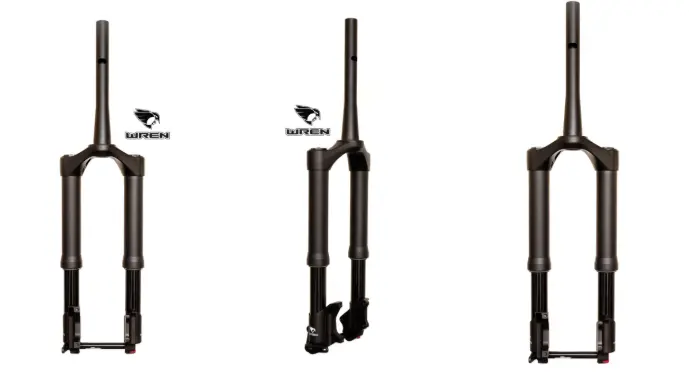
A teherforgalmi kerékpárok felfüggesztési villáinak típusai
1. Tekercsrugós villák
- Hogyan működnek: Használjon acél tekercsrugót a lökések elnyelésére.
- Előnyök: Megfizethető, tartós, egyenletes teljesítmény.
- Hátrányok: Nehezebb, kevésbé állítható.
- A legjobb: Nagy teherbírású városi teherbringák, amelyek értékelik a strapabírást.
2. Légrugós villák
- Hogyan működnek: Használjon sűrített levegőt az állítható merevséghez.
- Előnyök: Könnyű, a lovas súlyához és a rakomány terheléséhez igazítható.
- Hátrányok: Drágább, időnként karbantartást igényel.
- A legjobb: E-cargo kerékpárok, ahol a súlycsökkentés és a finomhangolás a prioritás.
3. Elasztomer vagy hibrid villák
- Hogyan működnek: Bízzon a gumi vagy polimer betétekben.
- Előnyök: Alacsony karbantartási igény, egyszerű kialakítás.
- Hátrányok: Korlátozott ütéscsillapítás, idővel romlik.
- A legjobb: Költségvetési teherbringák vagy belépő szintű felszerelések.
Miért érdemes megfontolni a felfüggesztési villát az elektromos teherautó kerékpárhoz? Itt vannak a Előnyök
1. Kényelem a lovas és az utasok számára
Gyermekek vagy érzékeny rakomány (például elektronikai cikkek, élelmiszer-szállítmányok vagy üvegtermékek) szállítása esetén nagy előnyökkel jár a simább utazás. A rugós villák csökkentik a rezgéseket és rázkódásokat.
2. Jobb kezelhetőség durva terepen
Ha az utcák macskaköves, villamossínekkel vagy egyenetlen burkolattal rendelkeznek, a felfüggesztés jobb kerékérintkezést és jobb irányíthatóságot biztosít.
3. Csökkentett váz- és rakományterhelés
Az ütések elnyelésével a felfüggesztés megakadályozza, hogy a folyamatos lökések átadódjanak a vázra, a dobozra és a rakományra.
4. Biztonság nedves vagy csúszós körülmények között
A kerék talajjal való érintkezése a bukkanók során csökkenti a megcsúszás esélyét.
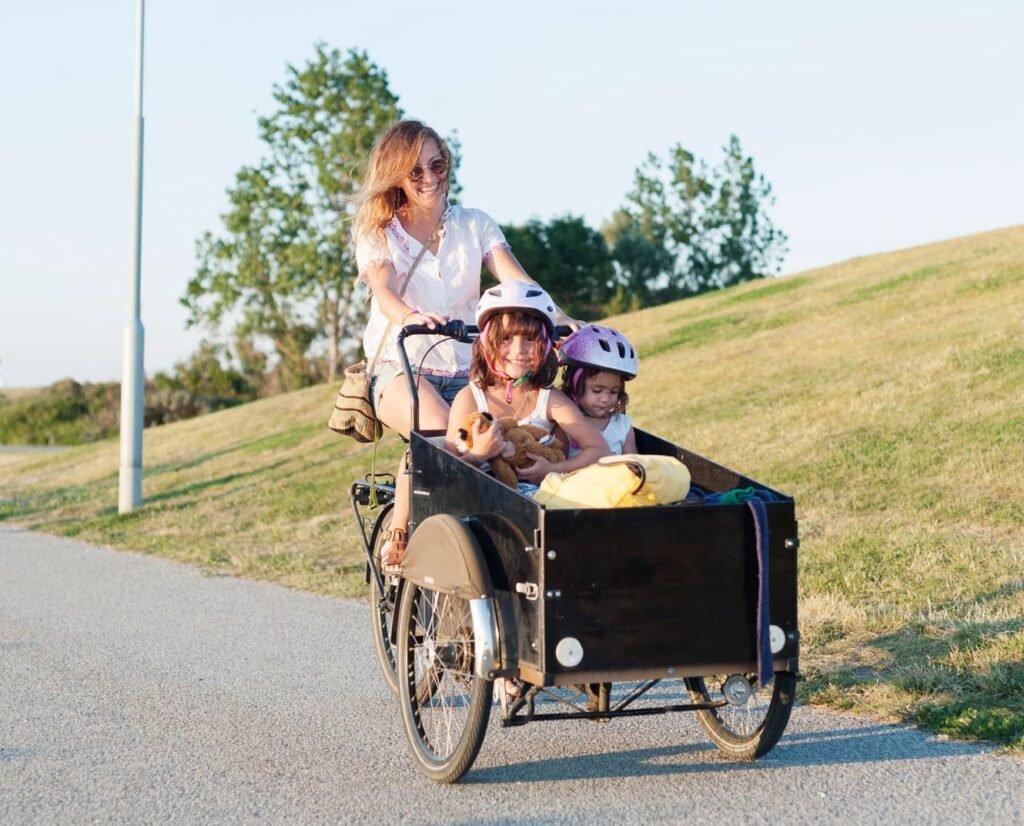
Mikor érdemes rugós villát választani?
Válassza az első felfüggesztést, ha kettő vagy több ezek közül az alábbiak közül:
- Szükséged van téli kényelem/vonóerő a nyomvályúk és a fagykárok felett.
- Gyerekeket hordozol és nyugodtabb utazást szeretnének, különösen egy bakfiets elején vagy egy longtail hátsó ülésein.
- A városodban érdes felületek: macskakövek, kátyúk, vasúti átjárók, fák gyökérzete.
- Az Ön útvonalai a következők kavics csatlakozók, sikátoros rövidítések vagy szervizsávok.
- Te lovagolsz nagy távolságok mérsékelt-nagy sebességnél (25-35 km/h), ahol a kis rezgések fáradáshoz vezetnek.
- Hozd el törékeny áruk (elektronika, pékáruk, műszerek), ahol a rezgésszabályozás fontos.
Kompromisszumok: Felfüggesztés: Miért nem használ sok teherforgalmi kerékpár felfüggesztést?
- Súly - A felfüggesztés 1-2 kg pluszt jelent, ami az amúgy is nehéz teherbringáknál nem mindegy.
- Költség - A minőségi rugós villák 200-500 €+ euróval növelhetik a kiskereskedelmi árat.
- Karbantartás - A mozgó alkatrészek karbantartást igényelnek, ellentétben az egyszerű merev villákkal.
- Stabilitás - Nagyon nehéz első terhelések esetén a felfüggesztés kevésbé kiszámíthatónak tűnhet a merev villához képest.
- Energiahatékonyság - A pedálozási energia egy része a villa mozgása során elvész (bár ez az e-cargo kerékpárok esetében kevésbé lényeges).
👉 Ez az oka annak, hogy sok márka inkább optimalizálja a teherbicikli gumiabroncsok vagy vázszerkezet a rugózás helyett a kényelemért.
Szóval, Mikor lehet kihagyni a rugóvillát?
Maradjon a merev villánál, ha az alábbiak közül a legtöbb igaz:
- Sima városi járda a normális; a legrosszabb, amit láthatsz, a kis repedések vagy a jól felhúzott fekvőrendőrök.
- Te kedveled maximális stabilitás nehéz frontterheléssel (pl. hivatásos csomag- vagy élelmiszer-kiszállítás).
- Alacsony karbantartási igény és flotta üzemidő trump komfort csípések.
- A kereted a kormányösszekötő rudazat vagy egy mély első doboz, ahol egy teleszkópos villa is lehet zavarja a kormányrudakkal, sárvédőkarokkal, rugóstagokkal vagy rakodófedéllel.
- Már futottál széles gumiabroncsok (pl. 2,4"+) ésszerű nyomáson, és elfogadhatónak találják az utazást.
- Szükséged van elülső állványok/ládák amelyek a vázhoz vagy a villa koronájához csavarozódnak a mozgó villalábakkal összeegyeztethetetlen módon.
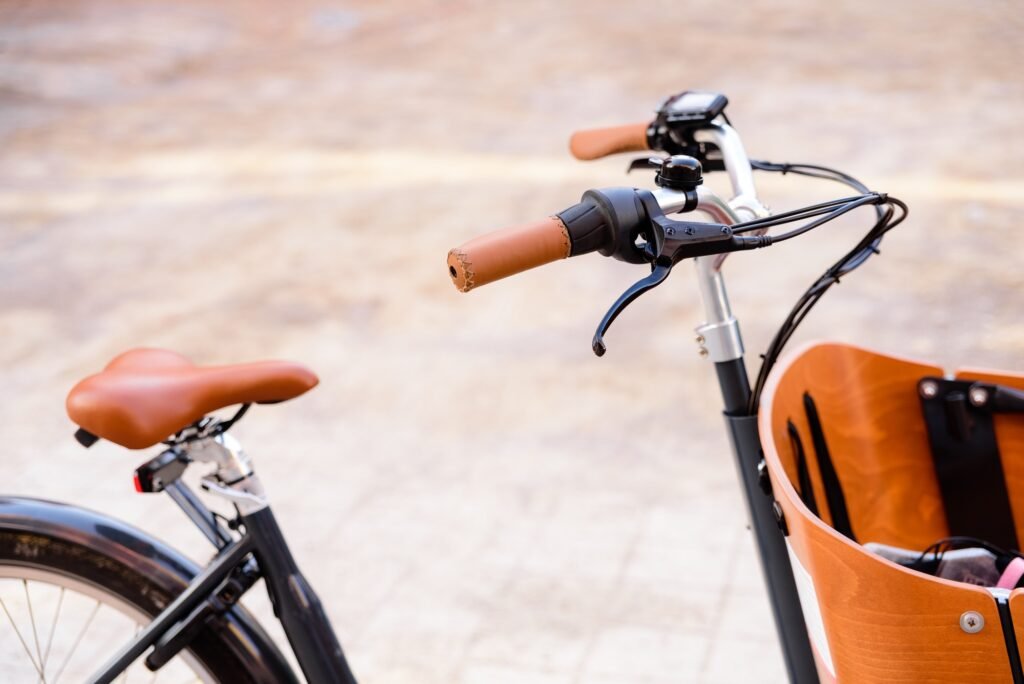
Felfüggesztési villa vs. merev villa: Melyik a jobb a teherforgalmi kerékpárokhoz?
| Jellemző | Merev villa | Felfüggesztési villa |
|---|---|---|
| Súly | Könnyebb | Nehezebb |
| Karbantartás | Minimális | Szervizelésre van szükség |
| Comfort | Gumiabroncsokra támaszkodik | Elnyeli az ütéseket |
| Költség | Alacsonyabb | Magasabb |
| Nehéz teherrel való kezelés | Nagyon stabil | Kicsit kevésbé kiszámítható |
| Legjobb felhasználási eset | Nehéz teher, városi utak | Családi túrák, vegyes terep |
Ítélet:
- Mert üzleti logisztika (futárok, csomagszállítás, élelmiszer-szolgáltatás), a merev villák + széles gumiabroncsok hatékonyabbak.
- Mert családok és vegyes használatú lovasok, a rugós villák növelik a kényelmet és a biztonságot, különösen, ha gyerekek vannak a fedélzeten.
Hogyan válasszuk ki a megfelelő felfüggesztési villát az Ön igényeihez?
Használja ezt ötlépéses ellenőrző lista hogy olyan villát válasszon, amelyik működik - és illik.
1. lépés - illeszkedés és kompatibilitás
- Kerékméret: Sok elülső rakodógép használ 20" frontok; hosszúfarkúak gyakran 26"/27.5". Egyezzen meg a villa kerék specifikációjával.
- Kormánycső: Egyenes 1-1/8" vs. kúpos (1-1/8" és 1,5" között). Ezt a fejcső dönti el.
- Tengely típusa és szélessége: 9 mm-es gyorskioldó vs. 12/15 mm átmenő tengely; az általános tengelytávolság 100 mm (elöl), de ellenőrizze.
- Féktartó és féktárcsa: Biztosítani kell a címet. post-mount kompatibilitás és szabad hely a 180-203 mm a teherbiciklikre jellemző rotorok.
- Keréktávolság és sárvédők: Ellenőrizze, hogy van-e hely 2,3-2,6"-es gumiabroncsoknak + sárvédők; ellenőrizze a fűzőlyukakat/tartókonzolokat, ha van ilyen. teljes fedésű sárvédők.
- Kiegészítő interferencia: Az elülső rakodógépeknél kormányösszekötő rudazat, erősítse meg, hogy a villa mozgása nem fog meghibásodni. kormányrudak, első állványok, vagy a doboz.
2. lépés - Válassza ki az utazást és az alvázat
- Utazás: Városi teherfuvarozáshoz, 50-80 mm az édes pont - elégséges megfelelőség nagy "fékezés" vagy geometria kilengés nélkül.
- Alvázmerevség: A villák előnyben részesítik a vaskos koronák és kereszttengelyek; a merevség megőrzi a kormányzás pontosságát terhelés alatt.
3. lépés - Válassza ki a rugót és a csillapítást
- Air ha akarod hangolható támogatás változó rakományhoz (változási nyomás és tokenek/távolítók).
- Tekercs ha értékeled egyszerűség és érzés; ellenőrizze a nehezebb rugós opciókat, ha gyakran teljesen megterhelt.
- Keresd meg külső lepattanás (kötelező) és ideális esetben, alacsony sebességű tömörítés/zárlat hegymászáshoz és sima ingázáshoz.
4. lépés - Beállítás a terheléshez
- Sag célpont: Lovas + tipikus rakomány esetén a következő célértékek elérésére kell törekedni 15-25% megereszkedés a teljes utazás. Túl lágy = dőlés/merülés; túl kemény = durva csattogás.
- A fék merülésvezérlés: Használat alacsony sebességű tömörítés és valamivel magasabb rugónyomás (vagy feszesebb tekercs), hogy ellenálljon az orr-lefelé billenésnek kemény megállások esetén.
5. lépés - Szolgáltatás és támogatás tervezése
- A szervizintervallumok 50-100 óra (könnyű tisztítás/olajozás) és 100-200 óra (tömítés/olaj) gyakoriak. Elfoglalt család vagy flotta? Tervezzen időt és alkatrészeket.
- Kedvelje a márkákat helyi szolgáltatás, alkatrészek, és tiszta súlyhatárok (a rendszer teljes tömege számít az e-cargo esetében).
Profi tipp: Először próbálja ki a gumiabroncsokat. Frissítés szélesebb, defektvédett gumiabroncsok a megfelelő nyomáson + a felfüggesztett nyeregcső gyakran 60-80% kényelemnövekedést biztosít minimális bonyolultság mellett - majd adjon hozzá egy villát, ha még mindig többre van szüksége.
Valós példák a felfüggesztéssel ellátott teherbringákra
- Riese & Müller Load sorozat - High-end e-cargo kerékpárok teljes felfüggesztéssel (elöl + hátul).
- Urban Arrow Family (opcionális felfüggesztés frissítés) - Népszerű családi közlekedés az európai városokban.
- Tern GSD felfüggesztett villával - Hosszúfarkú e-cargo kerékpár városi kényelemmel.
Ezek a modellek azt mutatják, hogy a felfüggesztés prémium kategóriás tulajdonság, amely általában a nagy teljesítményű vagy a családra összpontosító teherbiciklikben található meg.
Gyakorlati vásárlási tippek a teherforgalmi kerékpárok felfüggesztett villáihoz
- Ellenőrizze a felhasználási esetet - Szállítások sima utcákon? Maradjon a merevnél. Macskakövek és gyerekek? Fontolja meg a felfüggesztést.
- Válassza a légvillákat az E-Cargo számára - Könnyebb és hangolható a változó terheléshez.
- Vigyázzon a raktérre - A felfüggesztett első kerék megváltoztatja a geometriát; biztosítja a doboz távolságát és a kormányzás stabilitását.
- A szolgáltatás költségvetése - Számítson olajcserére és tömítéscserére 1-2 évente.
- Széles gumiabroncsokkal párosítva - Még felfüggesztéssel együtt is a gumiabroncsok maradnak az első számú kényelmi vonal.
Következtetés
Szóval, a teherbringáknak van felfüggesztésük? A válasz a következő: nem mindig - de megtehetik, és néha meg is kellene tenniük. A legtöbb teherbringát merev villával tervezték a tartósság és az egyszerűség érdekében, és széles gumiabroncsokra támaszkodva tompítják az utazást. A gyerekeket szállító családok, a törékeny árukat szállító vállalkozások vagy a durva városi terepen közlekedő kerékpárosok számára azonban a rugós villa jelentősen javíthatja a kényelmet, a biztonságot és a kerékpár hosszú távú tartósságát.
Végső soron a prioritásoktól függ, hogy merev vagy rugós villát választ-e.hatékonyság és stabilitás kontra kényelem és sokoldalúság.
Ha a teherbiciklik tervezésének minden aspektusát felfedezné, tekintse meg a teljes útmutatónkat. teherbicikli alkatrészek, ahol mélyebben belemerülünk a keretekbe, gumikba, állványok, és a teljesítményt befolyásoló tartozékok.




